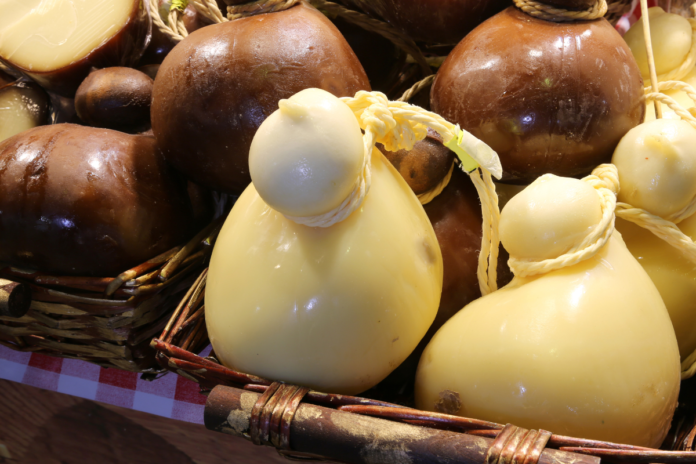Everything You Need To Know About This Italian Staple
Perhaps you’ve never heard of Caciocavallo cheese, a Southern Italian classic that has existed since ancient philosophers’ times. If you haven’t, don’t fret—this cheese is a well-kept secret that not many have discovered. Everything about Caciocavallo is unique. From its exciting shape to its complicated flavor profile, there isn’t an element of this cheese that doesn’t exist to impress. Today, we’ll discover not only how this cheese is created but also the best ways to enjoy it once you’ve finally gotten your hands on some.
The Roots of Caciocavallo
Caciocavallo is one of the most ancient varieties of Pasta Filata cheese, originating from Southern Italy, particularly prevalent in the Apennine Mountains region. The term “Pasta Filata” might ring a bell as it describes the distinctive production process employed in crafting other renowned Italian cheeses characterized by their stretched or pulled curd, such as Mozzarella and Provolone.
The name “Caciocavallo” can be literally translated to “horse cheese,” although horses have little to do with its creation. The name reflects the ancient practice of maturing the cheese by hanging it in pairs over a wooden beam, which can resemble saddlebags on a horse’s back.
Although there are substantial regional differences when it comes to Caciocavallo, all Italian manufacturers of the cheese have a deep respect for its original recipe and production process. This is so prevalent that the cheese has maintained a PDO mark since 1996. The entire cheese production process must occur within the specific region to receive the PDO status. This designation helps protect the product’s name and ensures that only items genuinely originating in that region are sold under that name.
How Quality Caciocavallo Is Created
So, what is this famous production process? In truth, its exact origins are unknown. However, some claim that this cheese is one of Italy’s oldest and that it was even mentioned by the philosopher Hippocrates. In any case, the journey of the cheese begins by retrieving raw milk from Italian cows.
Step One: Heating and Curdling
To begin with, the milk is gently heated to the perfect temperature and then introduced to a carefully measured amount of rennet. This addition triggers the milk to coagulate, gradually transforming it into the initial curd form. This early stage lays the foundational texture and character of the cheese.
Step Two: Cutting and Stiring the Curd
Once the curd has set, it’s cut into smaller pieces, a delicate process that encourages the whey to separate and release. Following the cutting, the curds are stirred and reheated to ensure the moisture content remains balanced. This reheating solidifies the curds’ structure, preparing them for the next phase.
Step Three: Stretching and Forming
The drained curds undergo traditional stretching and kneading by the skilled hands of the cheesemaker. This process, akin to a dance, infuses the cheese with its unique elasticity. The curds are then lovingly shaped to reflect the maker’s technique.
Step Four: Chilling and Brining
After the curds have been shaped into the distinctive form of Caciocavallo, they are submerged in cold water, tempering the cheese and halting the stretching process. Emerging, the cheese is then bathed in a brine solution, absorbing saltiness and beginning its maturation journey. The salt enriches the cheese’s flavor profile and prepares it for the final act of aging.
Step Five: Aging
The final chapter in Caciocavallo’s creation involves tying the cheese near its top to create a signature “neck.” Here, in the quiet of the aging room, the cheese is left to mature, developing its complex flavors over time. This period of rest is when Caciocavallo truly comes into its own as a culinary masterpiece!
Caciocavallo’s Flavor Profile And Characteristics
Caciocavallo is best known for its shape. It is traditionally presented as a large, oval ball with a smaller ball at the top. While the smaller ball isn’t always present, it is typically seen in the cheese. These two cheese pieces are separated by a marked neck.
These physical characteristics make the cheese quite hard to miss, but they aren’t the only distinguishing parts of Caciocavallo. The cheese’s complexity has little to do with how it appears and far more to do with how it tastes.
The flavor of your Caciocavallo will depend on its point in the aging process. Much like other cheeses, the older the cheese, the more complex the flavor. As Caciocavallo ages, its milky color begins to change into a deeper yellow, and the taste grows sharper and spicy. This change in flavor will typically occur about two months into the aging process.
However, if you don’t care for sharp cheese, don’t worry—Caciocavallo is much more than that. Before it is aged, its flavor is more salty and tangy, which allows it to pair perfectly with many other Italian staples. Below, we’ll cover exactly what to pair this cheese with to achieve the most full experience possible.
Common Caciocavallo Pairings
The best way to enjoy cheese is never to appreciate it alone. This is especially true of Caciocavallo, which can be elevated to entirely new heights with the help of a quality pairing. Here are some of the best foods and beverages to enjoy alongside this authentic Italian cheese.
Wines
A robust red wine is an exemplary companion to Caciocavallo, with the bold flavors of a Primitivo or a Sangiovese balancing the cheese’s intense notes. For those who prefer white, a crisp, acidic wine like Falanghina or Greco di Tufo can offer a delightful contrast.
Fruits and Nuts
The smoky and sometimes spicy taste of Caciocavallo pairs beautifully with the sweetness and acidity of fruits. Try serving it with fresh figs, pears, or tart apples for a refreshing contrast. For a textural play, dried fruits such as apricots or dates offer a chewy counterpart to the cheese’s firmness.
Charcuterie and Olives
For an authentic Italian experience, pair Caciocavallo with a selection of cured meats like prosciutto, salami, or coppa. The charcuterie’s saltiness beautifully offsets the mildness of younger Caciocavallo or the intense flavors of its aged variants. Add a mix of olives from the buttery Castelvetrano to the robust Kalamata to introduce a briny depth that ties the pairing together.
Elevate Your Pallette Today With Caciocavallo
Some overlook Caciocavallo because of its complex flavor and unique appearance. But those who are genuinely ‘in the know’ understand just how incredible this cheese can be. In essence, Caciocavallo is one of Italy’s best-kept culinary secrets. If you want to impress your friends or simply give yourself a deeper taste of authentic Italian cuisine, including Caciocavallo, it is the perfect way to achieve that.
The key to a quality meal is quality ingredients. The next time you search for what kind of food to prepare, consider adding some authentic Caciocavallo cheese. You’ll transform your home kitchen into a Sicilian restaurant in no time!

